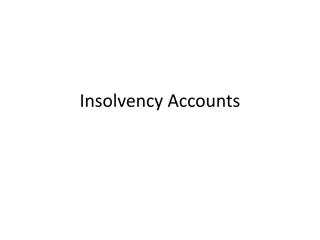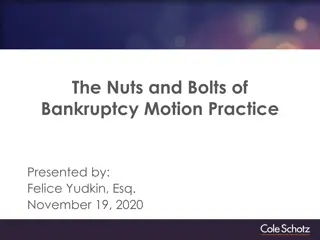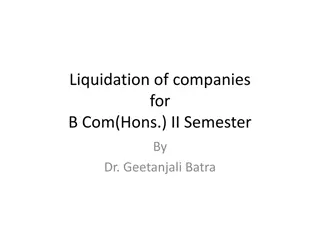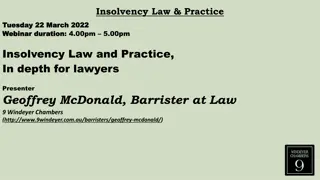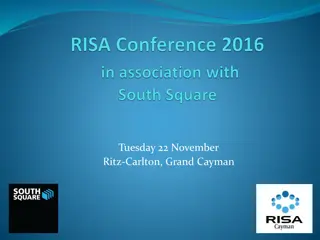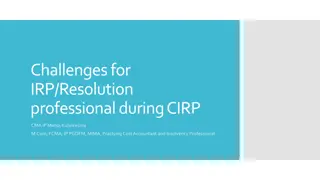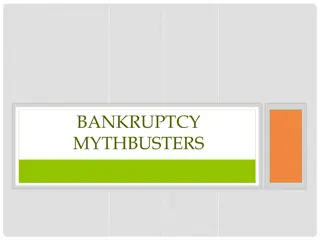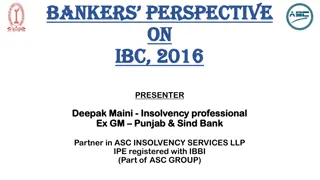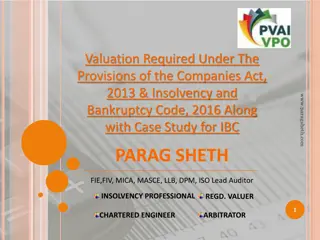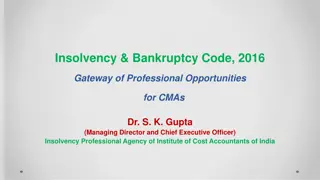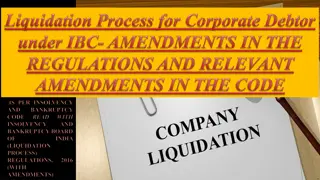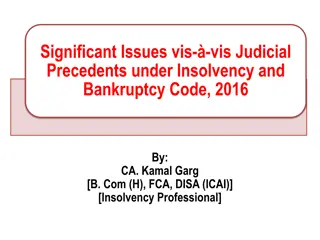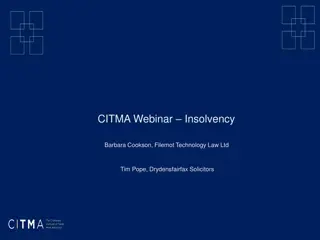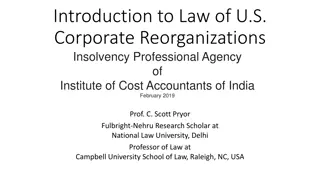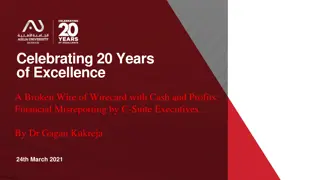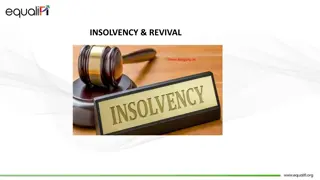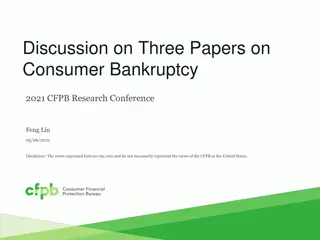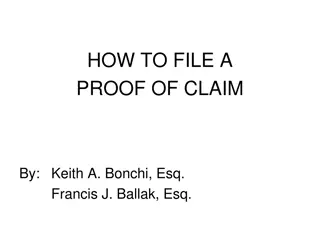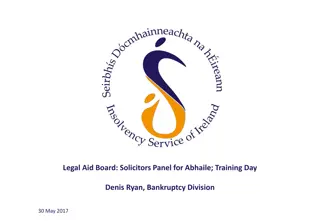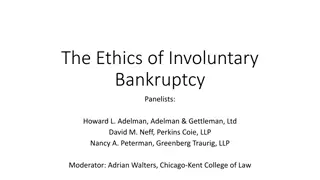
Insolvency and Bankruptcy Code, 2016- Boon and Curse
The Insolvency and Bankruptcy Code (IBC) 2016 provides a unified framework for resolving insolvency in India, aiming to streamline processes, reduce resolution time, and protect creditors. While it enhances financial stability and transparency, chall
Download Presentation

Please find below an Image/Link to download the presentation.
The content on the website is provided AS IS for your information and personal use only. It may not be sold, licensed, or shared on other websites without obtaining consent from the author. If you encounter any issues during the download, it is possible that the publisher has removed the file from their server.
You are allowed to download the files provided on this website for personal or commercial use, subject to the condition that they are used lawfully. All files are the property of their respective owners.
The content on the website is provided AS IS for your information and personal use only. It may not be sold, licensed, or shared on other websites without obtaining consent from the author.
E N D
Presentation Transcript
Affluence Advisory Pvt. Ltd. Insolvency and Bankruptcy Code, 2016- Boon and Curse Introduction: The Insolvency and Bankruptcy Code, 2016 (IBC) is an Indian Law which creates a consolidated framework that governs insolvency and bankruptcy proceedings for corporate person, partnership firms, and individuals. The Insolvency and Bankruptcy Code Bill was drafted by a specially constituted Bankruptcy Law Reforms Committee (BLRC) under the Ministry of Finance. The Insolvency and Bankruptcy Code was introduced in the Lok Sabha on 21 December 2015 and was subsequently referred to a Joint Committee of Parliament. The Committee submitted its recommendations and the modified Code was passed by Lok Sabha on 5 May 2016. The Code was passed by Rajya Sabha on 11 May 2016 and it received the presidential assent on 28 May 2016.. It provides a strong insolvency framework in which the cost and time spent on insolvency resolution process is minimized. Prior to the enactment of IBC, there were numerous laws to tackle insolvency such as Sick Industrial Companies (Special provisions) Act, 1985, The Provincial Insolvency Act, 1920, The Presidency Towns Insolvency Act, 1909, etc. Insolvency: Insolvency denotes the state of one whose assets are insufficient to pay his debt; or his general inability to pay his debts. The term insolvency is used for individuals as well as organizations/corporates. If insolvency is not resolved, it leads to bankruptcy in case of individuals and liquidation in the case of corporates. Bankruptcy: Bankruptcy denotes the legal status of a person or an entity who cannot repay debts to creditors. It is a formal declaration of insolvency in accordance with the law of the land. Bankruptcy occurs when a court determines insolvency and gives legal orders for it to be resolved. Applicability: Part II of Insolvency and Bankruptcy Code, 2016 (IBC) shall apply to matters relating to the insolvency of corporate debtors where the minimum amount of default is Rs. 1 Crore (Indian Rupees One Crore only) was specified by Ministry of Corporate Affairs vide notification dated 24th March, 2020, prior to which, the minimum amount of default was one lakh rupees. Key Objectives of IBC: The object clause of the Insolvency and Bankruptcy Code, 2016 lays down the following key objectives: CS Ritik Madnani | Affluence Advisory Pvt. Ltd. | Website - www.affluence.net.in |Email - connect@affluence.net.in
Affluence Advisory Pvt. Ltd. Insolvency and Bankruptcy Code, 2016- Boon and Curse To consolidate and amend the laws relating to re-organization and insolvency resolution of corporate persons, partnership firms and individuals to provide for a time bound insolvency resolution mechanism; To ensure maximization of value of assets; To promote entrepreneurship; To increase the availability of credit; To balance the interests of all the stakeholders including alteration in the order of priority of payment of Government dues; To establish an Insolvency and Bankruptcy Board of India as a regulatory Body; and To provide procedures for connected and incidental matters. Corporate Insolvency Resolution Process (CIRP): The expression Corporate Insolvency Resolution Process is defined in the Insolvency and Bankruptcy (Application to Adjudicating Authority) Rules, 2016. The IBC, 2016 provides that where any corporate debtor commits a default, a financial creditor, an operational creditor or the corporate debtor itself may initiate the corporate insolvency resolution process. Committee of Creditors (CoC): Committee of Creditors is a committee typically consisting of the financial creditors of the Corporate Debtor. It is the supreme decision-making body in a Corporate Insolvency Resolution Process (CIRP). Decisions regarding the administration of the corporate debtor are taken at the meetings of the Committee, based on a requisite vote of the members. It is responsible for giving approval to the IRP/RP to carry out actions that might affect the CIRP. The CoC s role underscores the importance of creditor participation and cooperation in achieving effective and timely resolutions under the IBC. Time Limit: The Corporate Insolvency Resolution Process shall be completed within a period of 180 days (One Hundred and Eighty Days) from the date of admission of the application to initiate such process. The resolution professional shall file an application to the Adjudicating Authority to extent the period of CIRP beyond 180 days, if instructed to do by a resolution professional passed at a meeting of the committee of creditors by a vote of sixty-six per cent of the voting shares. If the adjudicating Authority is satisfied, it may by order extent the duration of such process beyond 180 days by such further period as it thinks fit, but not exceeding 90 days (Ninety Days). CS Ritik Madnani | Affluence Advisory Pvt. Ltd. | Website - www.affluence.net.in |Email - connect@affluence.net.in
Affluence Advisory Pvt. Ltd. Insolvency and Bankruptcy Code, 2016- Boon and Curse However the maximum time limit to complete CIRP is within a period of 330 days (Three Hundred and Thirty Days) from the insolvency commencement date including any extension of the period of CIRP granted. Boon of IBC: The process of resolution is carried out in a time-bound manner, setting a strict timeline of 180 days, extendable by another 90 days, making the total maximum allowable period of 330 days from the insolvency commencement date. When insolvency is resolved through the code, there is certainty in the settlement of liabilities and ownership of assets. All liabilities, including government dues are settled. It prevents fraudulent activities by debtors as its assets and business activities are transferred from the debtor to an insolvency professional as soon as the application is admitted by the adjudicating authority. The IBC mandates the formation of a Committee of Creditors (CoC), which consists of representatives from the lenders and plays a crucial role in the decision making during the resolution process. This ensures that the process is more systematic. Insolvency Professional (IPs) are specifically trained and qualified to handle complex insolvency cases. This measure prevents debtors from continuing to manipulate assets or engage in fraudulent activities during the resolution process. The case law Essar Steel Insolvency Case has the significant example of how the IBC has streamlined the insolvency resolution process, improved the recovery for creditors, and reinforced the legal framework for insolvency in India. Curse of IBC: While the IBC legislation has great intentions, yet it suffers from several drawbacks, especially in its implementation. The lack of supporting ecosystem, causes significant delays in a time-bound execution. Lack of co-ordination between the parties in the process is faced which delays the insolvency proceedings. Since the code and its prescribed procedures are new, the insolvency professionals, adjudicators lack experience, which causes significant delay in proceedings or a company which have been ends up liquidated. During the insolvency resolution process, maintaining the company s operations can be challenging, leading to potential value erosion. CS Ritik Madnani | Affluence Advisory Pvt. Ltd. | Website - www.affluence.net.in |Email - connect@affluence.net.in
Affluence Advisory Pvt. Ltd. Insolvency and Bankruptcy Code, 2016- Boon and Curse Operational creditors, including suppliers and employees, may face uncertainties and delays in payments. The IBC process often involves complex litigation, leading to increased legal costs and prolonged disputes. There have also been instances where its implementation has faced significant challenges. One notable case that highlights some of these difficulties is the Jaypee Infratech Insolvency Case . Conclusion: The Insolvency and Bankruptcy Code, 2016, is an activist part of legislation intended to increase the effectiveness of insolvency and bankruptcy proceedings in India. Reference: https://www.mca.gov.in/content/mca/global/en/acts-rules/ebooks/acts.html?act=MzU0OTk https://portal.theedulaw.com/SingleNotes?title=reforms-committee-under-ibc https://lawbhoomi.com/a-historical-evaluation-of-insolvency-and-bankruptcy-laws-in-india/ https://thedailyguardian.com/merits-of-the-insolvency-and-bankruptcy-code-2016/ Insolvency and Bankruptcy Code, 2016 Disclaimer:This article provides general information existing at the time of preparation and we take no responsibility to update it with the subsequent changes in the law. The article is intended as a news update and Affluence Advisory neither assumes nor accepts any responsibility for any loss arising to any person acting or refraining from acting as a result of any material contained in this article. It is recommended that professional advice be taken based on specific facts and circumstances. This article does not substitute the need to refer to the original pronouncement CS Ritik Madnani | Affluence Advisory Pvt. Ltd. | Website - www.affluence.net.in |Email - connect@affluence.net.in

